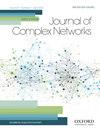Improving mean-field network percolation models with neighbourhood information
IF 1.5
4区 数学
Q2 MATHEMATICS, INTERDISCIPLINARY APPLICATIONS
引用次数: 0
Abstract
Abstract Mean field theory models of percolation on networks provide analytic estimates of network robustness under node or edge removal. We introduce a new mean field theory model based on generating functions that includes information about the tree-likeness of each node’s local neighbourhood. We show that our new model outperforms all other generating function models in prediction accuracy when testing their estimates on a wide range of real-world network data. We compare the new model’s performance against the recently introduced message-passing models and provide evidence that the standard version is also outperformed, while the ‘loopy’ version is only outperformed on a targeted attack strategy. As we show, however, the computational complexity of our model implementation is much lower than that of message-passing algorithms. We provide evidence that all discussed models are poor in predicting networks with highly modular structure with dispersed modules, which are also characterized by high mixing times, identifying this as a general limitation of percolation prediction models.利用邻域信息改进平均场网络渗流模型
网络渗透的平均场理论模型提供了节点或边缘去除情况下网络鲁棒性的分析估计。我们引入了一种新的基于生成函数的平均场理论模型,该模型包含了每个节点局部邻域的树形信息。当在广泛的真实网络数据上测试它们的估计时,我们表明我们的新模型在预测精度方面优于所有其他生成函数模型。我们将新模型的性能与最近引入的消息传递模型进行比较,并提供证据表明标准版本也优于标准版本,而“循环”版本仅在有针对性的攻击策略上优于标准版本。然而,正如我们所展示的,我们的模型实现的计算复杂度远低于消息传递算法。我们提供的证据表明,所有讨论的模型在预测具有分散模块的高度模块化结构的网络时都很差,这些网络也具有高混合时间的特征,这是渗透预测模型的一般局限性。
本文章由计算机程序翻译,如有差异,请以英文原文为准。
求助全文
约1分钟内获得全文
求助全文
来源期刊

Journal of complex networks
MATHEMATICS, INTERDISCIPLINARY APPLICATIONS-
CiteScore
4.20
自引率
9.50%
发文量
40
期刊介绍:
Journal of Complex Networks publishes original articles and reviews with a significant contribution to the analysis and understanding of complex networks and its applications in diverse fields. Complex networks are loosely defined as networks with nontrivial topology and dynamics, which appear as the skeletons of complex systems in the real-world. The journal covers everything from the basic mathematical, physical and computational principles needed for studying complex networks to their applications leading to predictive models in molecular, biological, ecological, informational, engineering, social, technological and other systems. It includes, but is not limited to, the following topics: - Mathematical and numerical analysis of networks - Network theory and computer sciences - Structural analysis of networks - Dynamics on networks - Physical models on networks - Networks and epidemiology - Social, socio-economic and political networks - Ecological networks - Technological and infrastructural networks - Brain and tissue networks - Biological and molecular networks - Spatial networks - Techno-social networks i.e. online social networks, social networking sites, social media - Other applications of networks - Evolving networks - Multilayer networks - Game theory on networks - Biomedicine related networks - Animal social networks - Climate networks - Cognitive, language and informational network
 求助内容:
求助内容: 应助结果提醒方式:
应助结果提醒方式:


